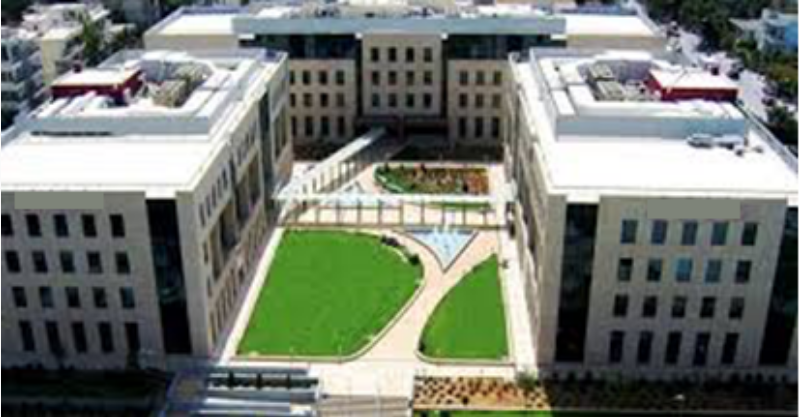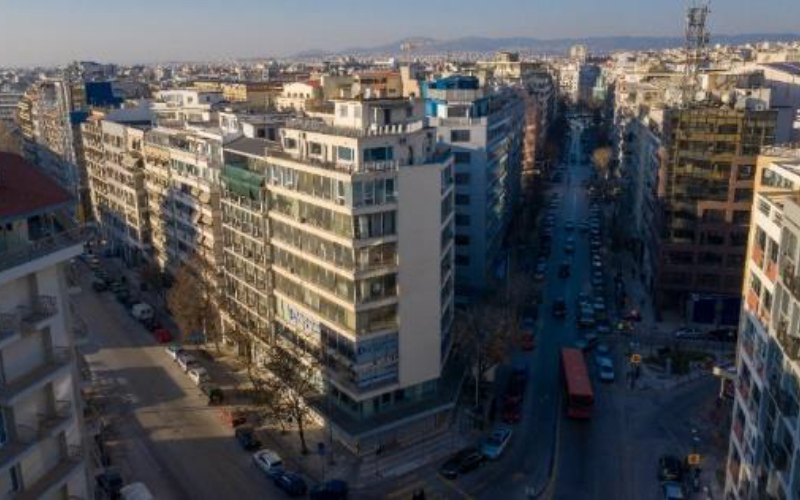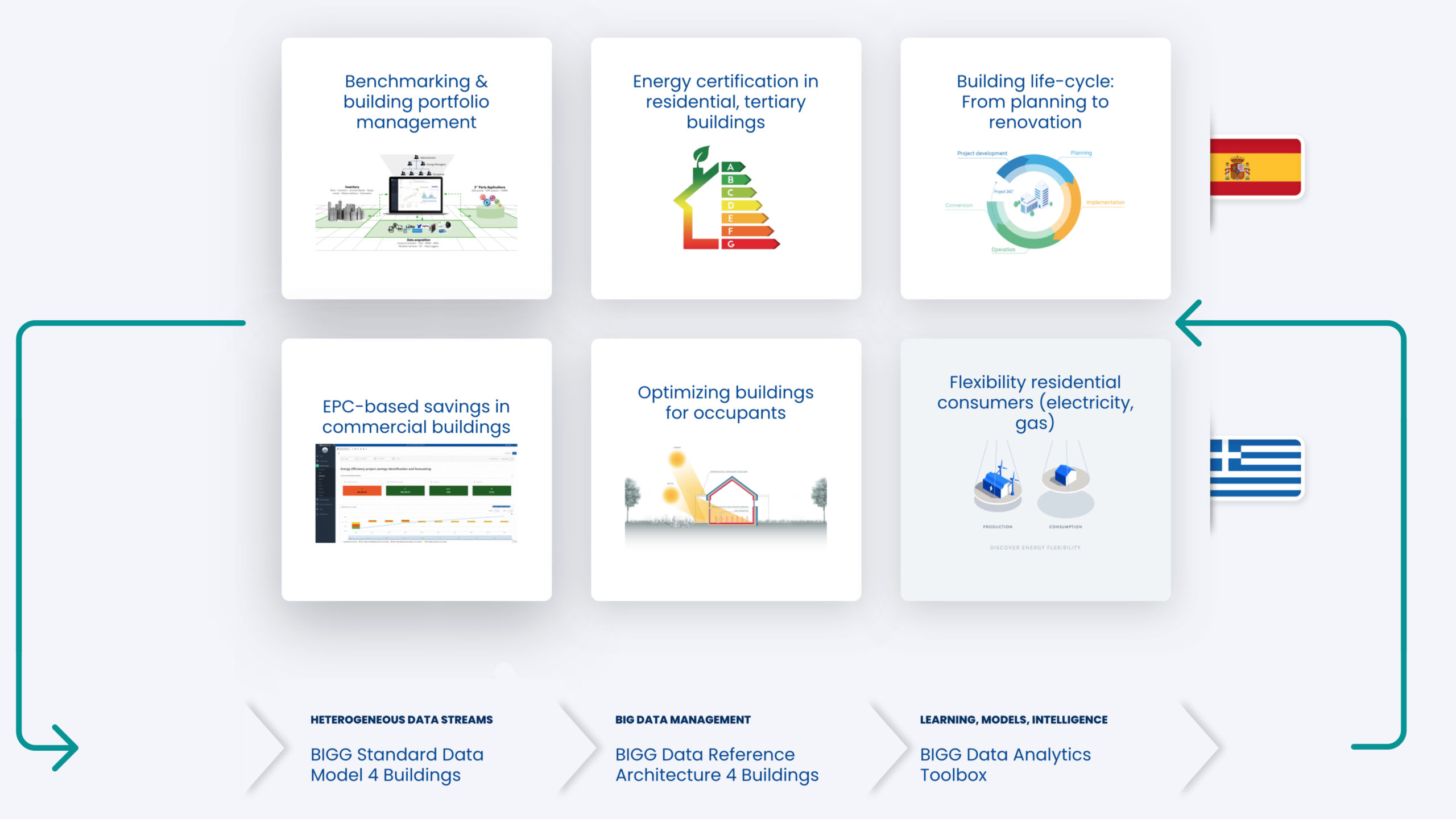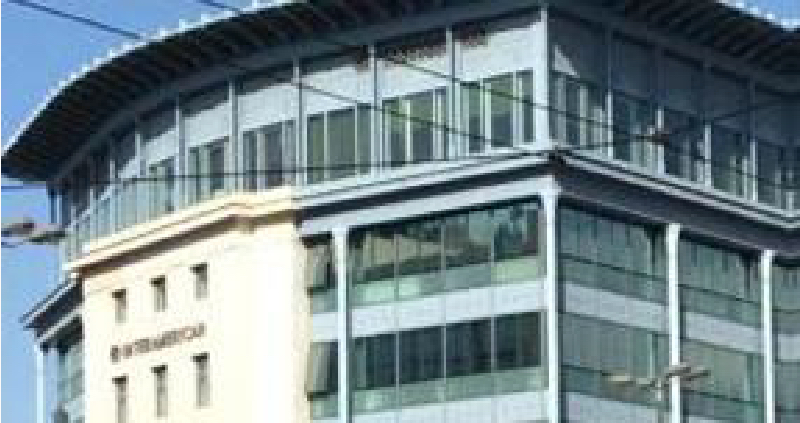The project BIGG (Building Information aGGregation, harmonization and analytics platform) launched in December 2020, demonstrates the application of big data technologies and data analytic techniques in the complete buildings life-cycle, in more than 4000 buildings in 6 large-scale pilots, 3 in Spain (Catalonia) and 3 in Greece.
BIGG is firmly grounded in reality and will start from a set of 6 high-level business cases, spanning a broad range of use cases as well as distinct international settings. A bottom-up business-case based methodology will be followed to define a widely applicable reference architecture. Each of the cases will be demonstrated in its own real-life pilots, building on the common architecture and toolbox.
The following picture represents a high-level view of the 6 business cases considered in BIGG pilots.
The first newsletter discussed the business cases supported by the Catalan pilots, which were focused on the needs of the public administrations to enhance the data gathering and analysis for monitoring the performance and improving the energy efficiency of the building stock.
This second newsletter focusses on the business cases supported by the Greek pilots.
BIGG Greek Pilots Business Cases
The Greek pilots are divided in Business Cases 4&5 and Business Case 6. The first ones focus on 17 large commercial office buildings in Athens managed through Energy Performance Contracting (EPC4) and Maintenance Contract. The pilot site will demonstrate the application of EPC-based management for commercial buildings, whose main objective will be continuously optimizing the building operation consumption, to guarantee comfort of occupants, by controlling HVAC systems/lighting. The pilot scenario for the Business Case 6 will focus on delivering flexibility services by managing appliances of residential and commercial consumers of electricity and natural gas, spread across various cities of Greece (Athens, Thessaloniki, Volos and others).
Business Case 4: Energy Performance Contract-based savings in commercial buildings
The objective of this Business Case 4 (BC4) is to create a solution for a comprehensive management of EPC contracts. This solution will have to enable smooth communication between the Energy Service Company (ESCO), managing the EPC, and the customer who has to be notified in case of any major savings deviation or corrective actions required. This BC4 will consist mainly on the control of different systems of customer buildings, as HVAC or lighting in order to improve its energy efficiency. Different steps include the definition of KPIs, KPIs monitoring and KPIs related data collection.
This business case consists in 3 use cases:
Use Case (UC) – Buildings assets management
This UC will consist in collecting and monitoring static (e.g. building and operation details) and dynamic (e.g. ambient & external conditions, consumptions) data relevant to the management of an EPC contract.
The main objective is to structure the data collection process to enable the storage of all relevant information for the management of EPC contracts.
The general approach of this UC is:
- Data collection (energy meters and environmental sensors) from buildings managed by Engie Hellas
- Predictive algorithm creation for asset management using existing data.
Use case – Actual savings tracking realised by the Energy Conservation Measures (ECMs)
This UC focuses on pre-existing buildings, so measures will be mainly linked to consumptions adjustments and optimization of internal conditions, rather than design plans.
The objective is to track the actual impact of ECMs and verify the associated savings according to a standardized process.
The pilot project will be conducted in a 7-floor office building of 13.500 m2 and 20 years old.
The ECM that will be implemented are: Boiler optimization, HVAC control, Chillers control, VSDs to pumps and Engie connecting to Platform.
Use case – EPC Contract Management to manage EPC-life-cycle and perform actions
The objective of this UC is to simplify the management of an EPC contract on a single platform leveraging the template data collection process both static and dynamic and the ECM tracking capabilities.
This UC will report savings achieved as a result of implementing some ECM. The reporting mechanism will be agreed by all interested parties on a bi-annual schedule.
Some of the expected improvements are: to fasten the EPC definition process and build tools for contract follow up in different phases, incorporate ECM actions management tool, defining energy and valuable financial KPIs, to build contract management dashboards, to improve tools used for the energy management of the buildings.
Business Case 5: Buildings for occupants – Comfort case
The idea is to optimize comfort in buildings, using Building Management Systems (BMS) and based on the outside weather, a programed occupancy schedule and forecast of energy prices.

This business case consists of 3 use cases:
Use case – Optimisation using weather forecasts
Weather conditions have a direct impact on the energy demand of buildings and RES production. In this UC, by weather forecast it will be proactively matched energy demand and supply
The objective is to develop a control algorithm to optimize energy usage by taking into account the weather forecast.
Use case – Optimisation using occupancy forecasts
Occupancy is another factor directly affecting demand mainly on cooling, heating and lighting.
A control algorithm will be developed considering occupancy forecasts together with weather forecasts to optimize energy usage on site.
Variables such as expected occupancy in one hour will be part of the decision-making process to control other devices in a smart and autonomous way.
Use case – Optimisation using energy price forecasts
This UC will develop a control algorithm using energy prices forecast, in addition to weather and price forecasts from the two preceding use cases. Facility managers will have the capacity to follow up cost savings with an extra dashboard.
Business Case 6: Flexibility potential of residential consumers on electricity and natural gas
This BC will demonstrate and exploit the flexibility potential of residential and commercial buildings in electricity and natural gas.
The focus will be on characterizing the availability and distribution of flexible loads in the buildings by analyzing a plurality of data captured from heterogeneous sources: devices deployed at consumer premises (smart meters, heating controllers, Internet of Things – IoT sensors, etc.), user preferences (comfort limits, schedules, etc.) collected through smartphone applications, external services (weather forecast, balancing market prices, consumption & billing) and static information, such as the building characteristics, as captured by the building EPC.

This business case 6 consists of 2 use cases:
Use case – Electricity demand response (DR)
In this UC, up to 200 electricity consumers will participate in DR schemes, by actively monitoring and managing the consumption and status of home appliances (e.g. water and space heaters), by using smart meters, relays, plugs and IoT sensors (motion, temperature, etc.). End users will directly interact with the system with a smartphone application to provide their preferences and benefit from automated actuation based on rules/events set both by themselves or by agreed DR requests in the context of demand side flexibility (DSF).
Use case – Natural Gas demand response (DR)
In this UC, 100 natural gas consumers will upgrade their legacy space and hot water heating boilers with the cost-effective heating controller smartphone application of domX. Optimal management of natural gas consumption in buildings will be enabled, by actively controlling and optimizing the boiler operation in real- time, towards (a) improving the attained energy efficiency up to 35% and (b) contributing to energy system flexibility providing real-time gas balancing services. In both scenarios, the energy management algorithm will constantly guarantee the user specified comfort limits and take into account the specific building and boiler characteristics and the prevailing weather conditions.






